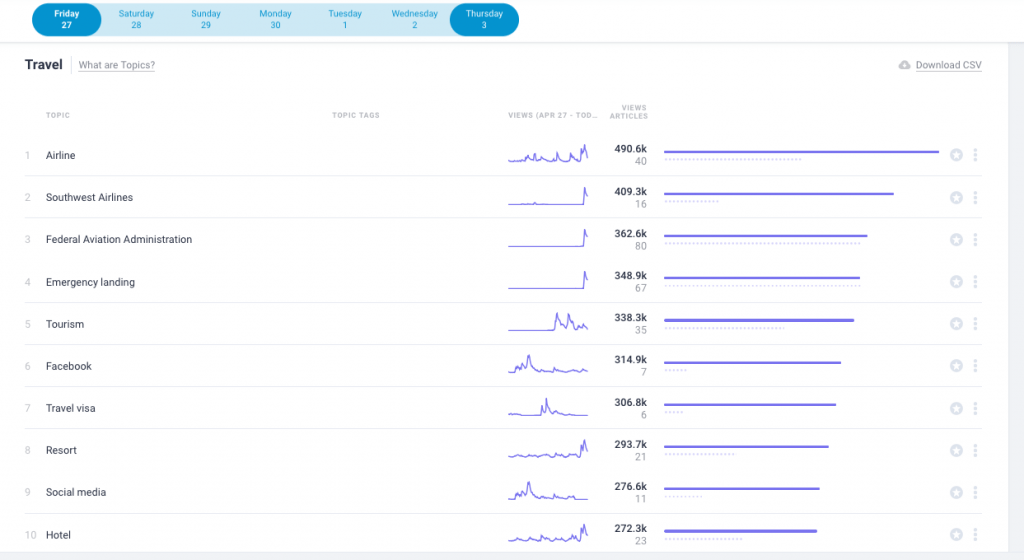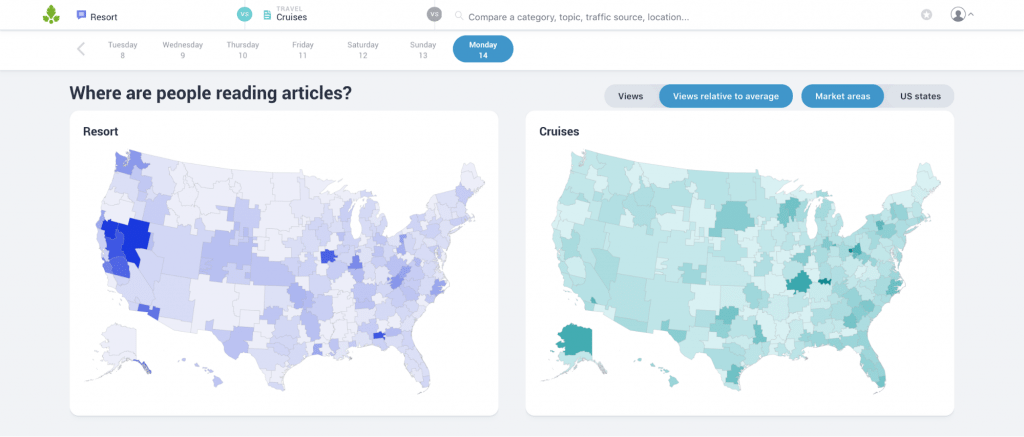How travel brands can use audience data to think strategically about customers’ digital moments

This post is a collaboration between SkiftX, Skift’s branded content studio, and Parse.ly. It originally appeared as sponsored content on Skift.
Online content is a powerful marketing vehicle, but it can’t be successful without a true understanding of one’s audience and authentic, engaging messaging that resonates.
Fortunately, travel brands are uniquely positioned to leverage the incredible power of online content for marketing and engagement. Since this is an industry that aims to inspire wanderlust and encourage life-changing experiences, customers’ digital moments of adventure and inspiration are a natural target for travel brands’ engagement.
SkiftX spoke to Clare Carr, vice president of marketing at Parse.ly, a company that provides audience attention data to digital brands and publishers, about why travel companies need to hone in on what has their customers’ attention—their stories, excitements, discoveries, and priorities—and then act on that data to drive messaging around these moments that matter.
As Carr explained, audience data allows for informed storytelling that inspires brand loyalty. “Content works best when people can connect to it through moments that matter to them. Travel has such a strong emotional connection and it’s so aspirational. It’s one of those areas that people can’t get enough of.”
Using its new Currents product, which shows the aggregate interests of over 150 million people reading 850,000 articles posted on high-traffic, premium content sites each day, Carr found three examples of how brands can use data to create content strategy that inspires travelers throughout the customer journey.
1. Find a new angle on the story
When it comes to publishing travel-related content, it’s easy to fall into a pattern and rely on covering repetitive or overdone topics. To break free of those tendencies, look at specific areas of interest within travel.
For example, using its Currents product, Parse.ly looked at aggregate page views for the most popular topics of travel-related articles published within the Parse.ly network between Friday, April 27th and May 3rd, 2018. The image below shows that “Airline” was the top travel-related topic during this timeframe, with 490.6k views across 40 different articles.

The end of the week saw a heavy spike around Southwest Airlines Flight 1380, which made an emergency landing after one of the plane’s engines failed catastrophically. Page views were especially high for articles related to the emergency landing and the Federal Aviation Administration (FAA). For content publishers, this might present an ideal opportunity to calm nervous flyers or be a time to avoid publishing flight-related stories.
Earlier in the week though, stories relating to airlines had a distinct social media and Facebook thread, which means it may have been a prime time to amp up social media campaigns, assuming that content was favorable.
Data like this can help take the guesswork out of the creative process and provide perspective on what matters to travelers at an exact moment. Understanding what readers are interested in, whether it’s breaking news about a certain airline, or tourism tips, can inspire storytelling that impacts brand loyalty.
2. Pinpoint what travelers in different locations pay attention to
Data from Parse.ly shows that the type of content readers consume varies by location. Comparing “cruise-related content” to “resort-related” content in Currents revealed where audiences in different parts of the U.S. read more about each topic.
The maps below show page views for articles about each topic in major U.S. market areas, with darker color gradients indicating higher page views relative to the average. The data showed that on May 14, 2018, the west coast was reading about resorts, with a high concentration of people reading about cruises in Hawaii. Insights like these can help you decide where to run an ad campaign or reveal what locations to focus on in the content creation and sales processes.

3. Know how your readers pay attention
Data can reveal how readers find and access content, whether it’s through search, social media, or another channel. Understanding how readers engage with content directly impacts how and where a brand should publish and promote.
When looking at travel-related articles published within seven days across the Parse.ly network, Parse.ly found that “Text, Email, & Direct traffic” were most influential in leading audiences to travel content, with social media sites coming in second.

Here, direct outreach channels like newsletters and SMS/Whatsapp offers might be driving high engagement. If those aren’t already integrated into a brand’s travel content, this is a good indicator that they should be considered.
The Goal: Asking the Right Questions About Your Content and Audience
While marketers can identify certain storytelling methods that are most effective, such as vivid imagery, compelling video, and thought-provoking long-form content, Carr explained that understanding your audience’s needs and interests is more important than the medium you use to engage them.
Honing in on your audience’s priorities requires publishing content crafted around interests they’ve expressed, then vigorously analyzing how they respond so that you can understand which storylines inspire people most. This virtual cycle—essentially a conversation between the brand and its audience—is what Carr sees as the beating heart of capturing digital moments. “Seeing people’s reactions and then tracking and doubling down on them is the exciting part of content marketing,” she said.
Considering that effective online engagement is an iterative process that aims at long-term development of an audience, it’s a mistake to expect quick, measurable return from content marketing. “Companies often have overinflated expectations of content,” explained Carr. “It’s so easy to say, ‘What did this content do for me this month?’ But that’s not the right question to ask.”
Instead, companies should ask things like: How are we thinking about our stories? How are we evolving over time? How are we connecting with our audience so they will respond how we hope they respond? How is our content inspiring them to click through from the platform they’re on to our website and engage with us there?
Parse.ly Currents can help brands find data that inspires them and answers these questions. Currents is the world’s first live view of over 150 million people’s attention every day. Built on Parse.ly’s network of 2500+ of high-traffic, premium content sites, Currents shows the aggregate interests of 150 million people reading 850,000 articles each day. To sign up for the Currents beta waitlist, visit https://www.parse.ly/currents/.
To learn more about how your travel brand can leverage analytics to engage with customers, visit https://www.parse.ly/travel-marketers/.